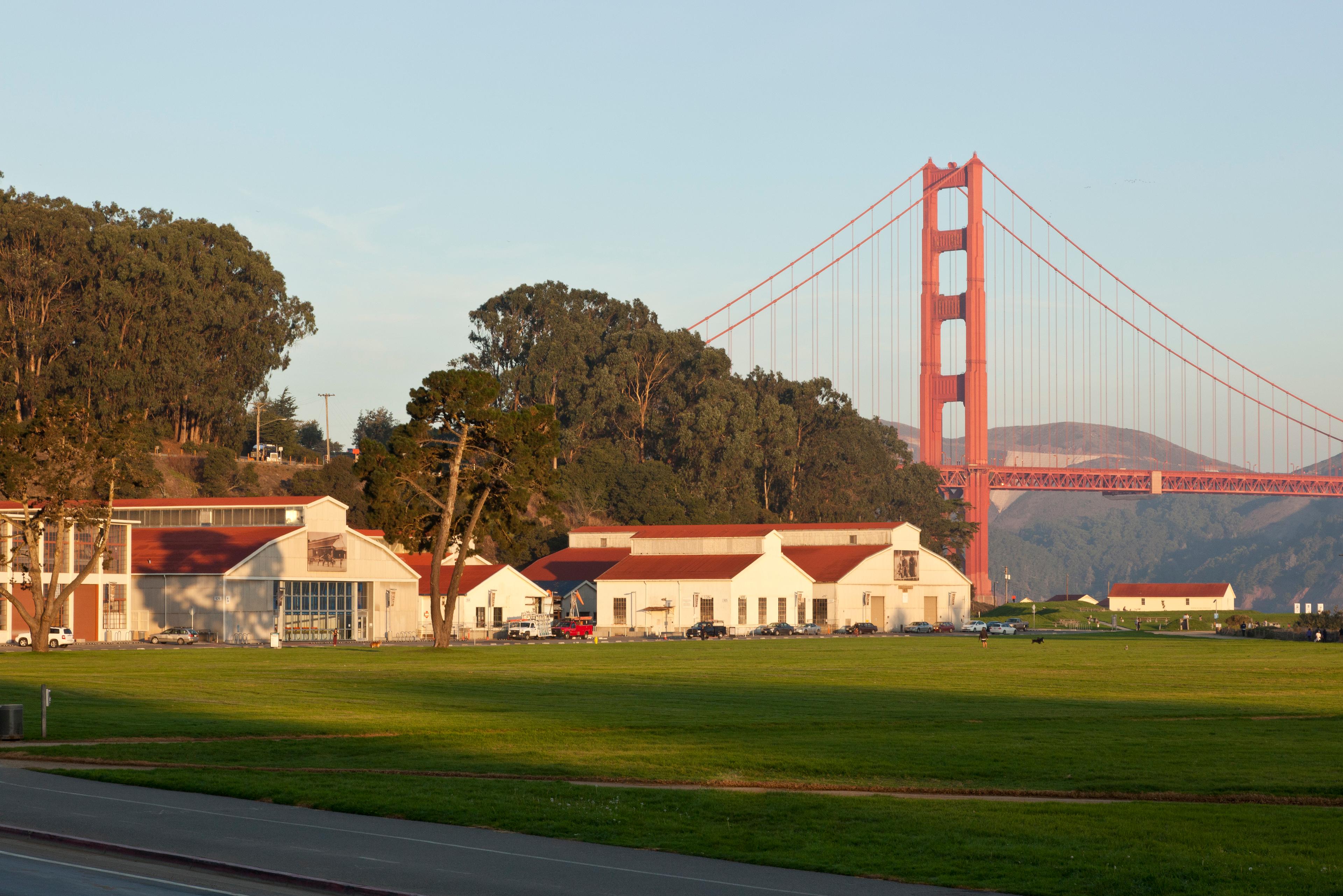Apr 16, 2024
History of the Golden Gate Bridge in the Presidio
Explore the Golden Gate Bridge's rich past in the Presidio in this brief historical journey.The histThe history of the Golden Gate Bridge is as long and colorful as the landmark itself. Learn the backstory behind San Francisco’s most famous bridge, including insights on the Presidio’s first settlers, details on the Golden Gate’s construction, and highlights from its milestone celebrations.
A lot has changed in the last 18,000 years! Believe it or not, back then, the San Francisco Bay did not even exist! Instead, the area was occupied by a vast meadow that emptied into the ocean, which would eventually fill with glacier melt from the Sierra Nevada.
Today, the place we know as the Golden Gate Strait is revered both for its vast natural beauty and for the human-made marvel of engineering that has connected Marin and San Francisco Counties since 1937. Read on for a quick crash course on the history of the Golden Gate Bridge, its intractable relationship with the Presidio, and some of the most memorable moments the structure has enjoyed thus far.
1. When was the Golden Gate Bridge built?
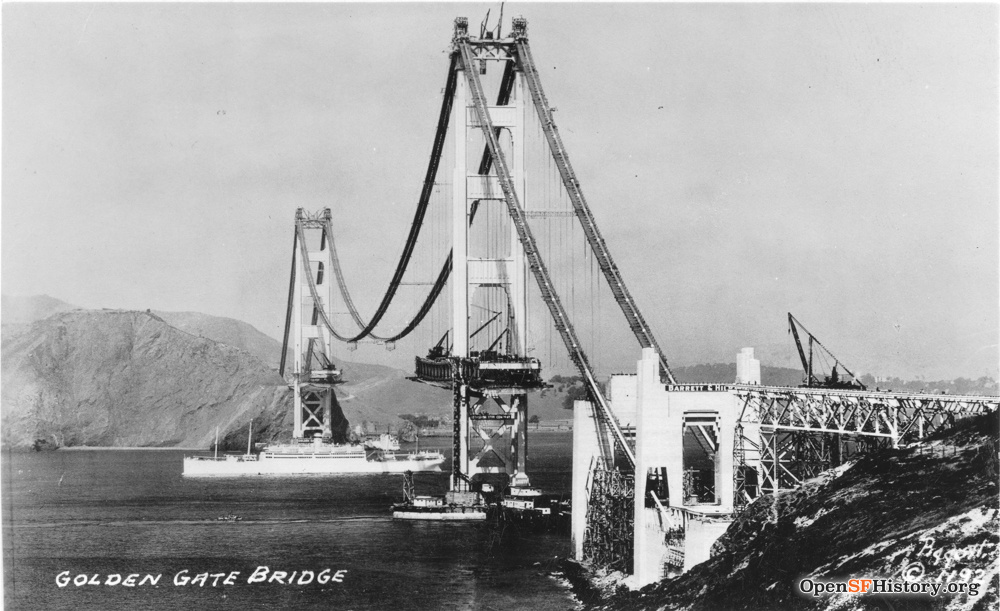
The land upon which the Golden Gate Bridge now sits was and is part of the traditional territory of the Yelamu, a local tribe of the Ramaytush Ohlone peoples. Archeological studies of remains found at Crissy Field indicates the Yelamu lived here when plants, fish, and other animals were available for harvest.
In 1776, Spanish explorers discovered the area and established the Presidio as a settlement with eyes towards guarding the bay from other European powers and protecting the nearby Mission San Francisco de Asís. After Mexico achieved its independence from Spain in 1821, the Presidio became a Mexican outpost, where one of its most famous residents was Doña Juana Briones de Miranda. A pioneer in multiple fields, she was one of the first three settlers in Yerba Buena, known today as San Francisco.
During the Mexican American War of 1846-1848, the U.S. Army began using the crumbling Presidio as a post, establishing the roots of an occupation that would last until 1994. Later, the area’s natural splendors and strategic location would convince organizers to select the Presidio as the site of the 1915 Panama-Pacific International Exposition, further heightening the site’s public prestige. Soon, the Presidio would develop into the most important Army post on the Pacific Coast.
By the early 1920s, chatter about plans to build the world’s longest suspension bridge across the Golden Gate Strait began to reach a fever pitch. The biggest question: was it possible?
2. Who designed the Golden Gate Bridge?
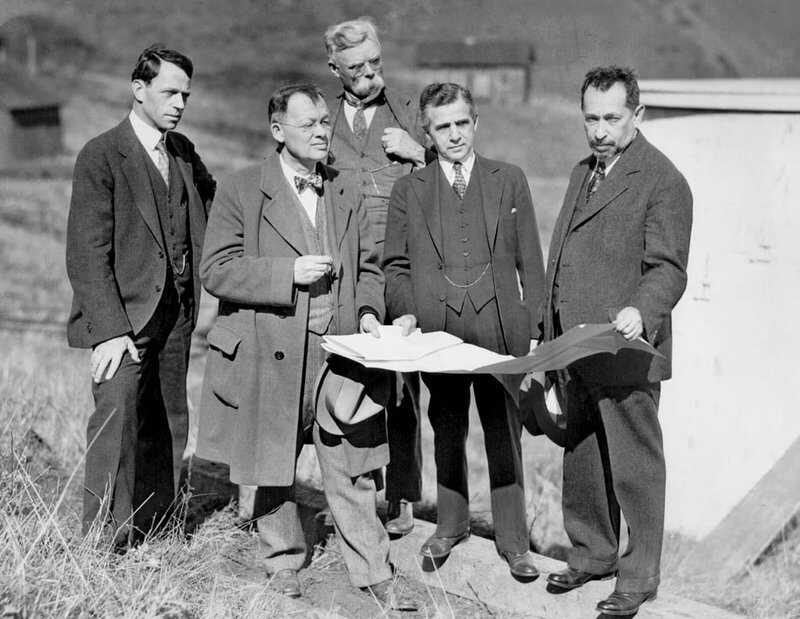
Though the idea of building a bridge across the Golden Gate Strait capable of connecting San Francisco to Marin was broached as early as the 19th century, the first concrete action on the matter took place in 1919. That’s when San Francisco city officials tasked an engineer with exploring the feasibility of such an undertaking. By 1930, the basic design for a suspension bridge spanning 1.7 miles was approved under the leadership of the newly formed Golden Gate Bridge and Highway District.
The aesthetic origins of the Golden Gate Bridge can be credited to architectural designer Irving Morrow, who also chose the structure’s signature color. Known officially as International Orange, Morrow felt the shade would stand out against the surrounding land, sea, and ever-present fog. Meanwhile, the esteemed trio of Joseph Strauss, Charles Ellis, and Leon Moisseiff collaborated on the bridge’s engineering design.
After a long series of public uproars, false starts, and countless revisions, construction on the Golden Gate Bridge officially commenced on January 5, 1933.
A month after construction on the Golden Gate Bridge got underway, an official groundbreaking ceremony was held at nearby Crissy Field. The celebration on February 26, 1933, which saw at least 100,000 people attend, featured a festive parade through the Marina District, including a group of engineering students carrying an 80-foot replica of the bridge. It also included the release of 250 carrier pigeons, provided by the San Francisco Racing Pigeon Club to “carry the message of groundbreaking to every corner of California”, per a local newspaper.
For more information, view the official 1937 groundbreaking ceremony program.
3. How was the Golden Gate Bridge built?
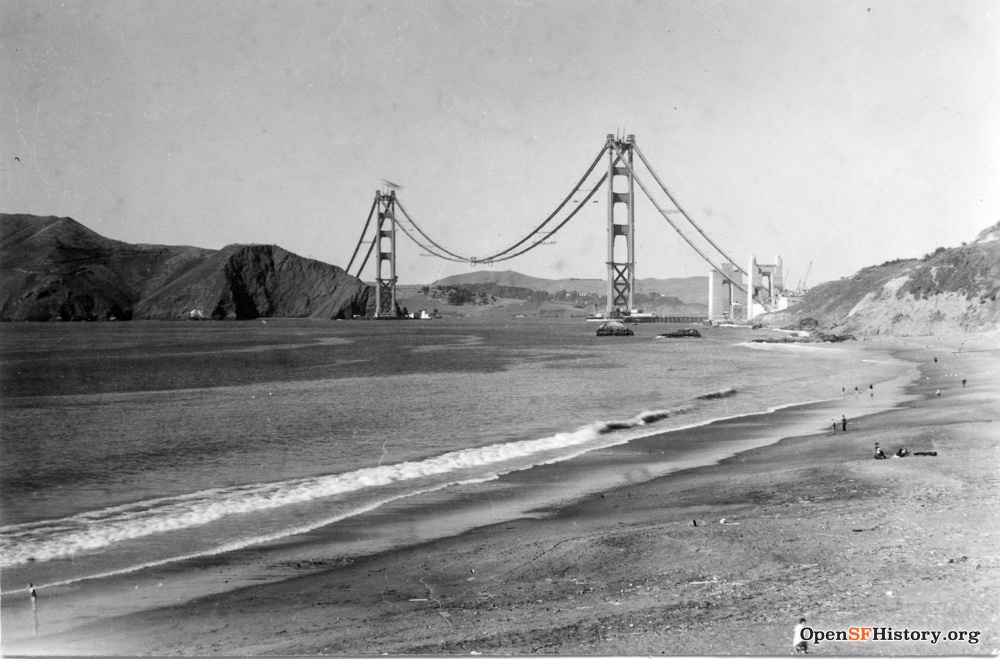
Following these early festivities, it was time to get to work. Carried out by multiple prime contractors and subcontractors, the massive undertaking of constructing the Golden Gate Bridge would take four years to complete, finishing on April 19, 1937.
To build a bridge capable of supporting motorists, the first step was to construct huge concrete piers in the bay at each end of the bridge. Then the towers were built, and the cables drawn between them. Finally, sections of roadway were lifted into position and connected to the Marin and San Francisco approach roads.
3. Who built the Golden Gate Bridge?
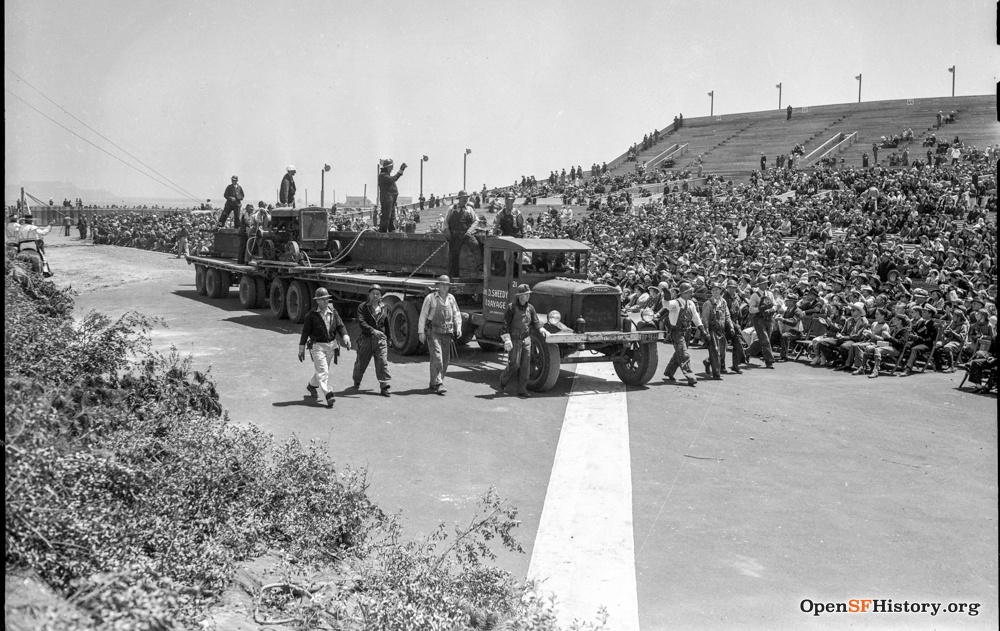
Despite efforts to encourage safety, the work was often treacherous. On October 21, the bridge claimed its first fatality when Kermit Moore was killed by a falling piece of equipment. The following winter, on February 17, 1937, ten more men died when a scaffold they were working on fell through a safety net. Sadly, owing to incomplete employment records, the names of many of the workers who labored on this project are lost to history.
By the time the Golden Gate Bridge was completed in 1937, the project had reached a cost of $35 million, or the equivalent to $523 million in 2019. The resulting structure was also, at the time, the longest and tallest suspension bridge in the world. On May 27, the bridge was officially opened to the public. The following day, it welcomed its first motorists, who were granted access once President Franklin Delano Roosevelt pressed a special telegraph key from his office in the White House, declaring the span “open to the entire world.” The toll was $0.50 per car, each way.
Stop by the Golden Gate Bridge Welcome Center during your next visit to the area to learn more about this period.
4. Noteworthy Golden Gate Bridge Celebrations
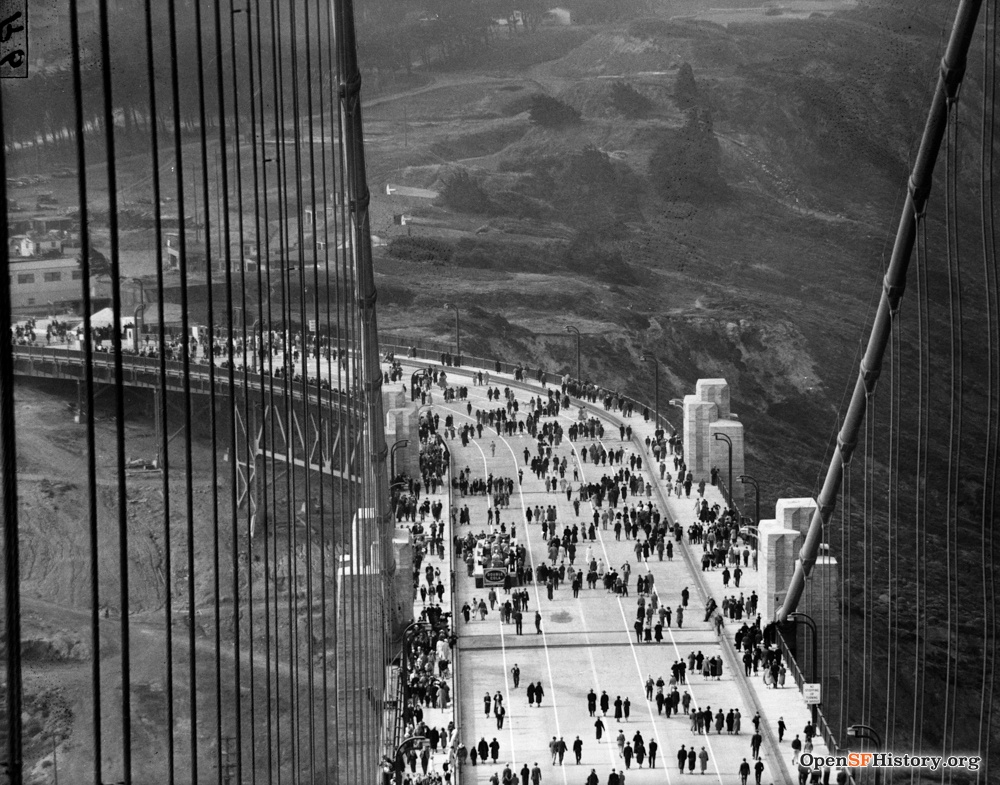
To commemorate the seminal achievement of completing the Golden Gate Bridge, elected officials gathered with the residents of San Francisco and the surrounding Bay Area to throw themselves a party.
Prior to granting access to motorists, the bridge was first launched with a “Pedestrian Day” on May 20, 1937. Made solely available to pedestrians from dawn until dusk, an estimated 18,000 people were already in line to cross by 6 a.m. Throughout the day, officials estimate 15,000 visitors an hour passed through the turnstiles, with a total of roughly 200,000 coming out for the occasion.
A half-century later, on May 24, 1987, the Golden Gate Bridge celebrated its 50th Anniversary, drawing an estimated 800,000 people — over ten times the size that officials were anticipating! Incredibly, 300,000 still managed to walk across the bridge, temporarily flattening its normally arched roadbed in the process. While engineers were momentarily concerned, the Golden Gate Bridge ultimately sustained no lasting damage.
Learn more details about 1937’s Opening Fiesta Week and the 50th Anniversary celebration from the Golden Gate Bridge Highway and Transportation District’s official website.
5. Major Milestones of the Golden Gate Bridge
When you’ve been around for 91 years, you’re bound to amass some memorable moments along the way. The Golden Gate Bridge is no exception, boasting a bounty of interesting milestones from throughout its nine-decade (and counting!) tenure.
They include the date the billionth car crossed the bridge (February 22, 1985), World War I veteran Harold Wobber’s ominous distinction of being the first person to take their own life by leaping from the landmark (August 7, 1937), and the four weeks following the Loma Prieta earthquake of October 17, 1989, during which the Golden Gate Bridge saw its highest volume of daily traffic to date with a peak of 162,414 vehicles crossing on October 27.
The Golden Gate Bridge has also been the worthy recipient of numerous accolades and recognition. On February 16, 1994, the American Society of Civil Engineers proclaimed the bridge to be one of the seven civil engineering wonders of the United States. Shortly thereafter, in 1998, the Golden Gate Bridge received its own U.S. postage stamp. This was followed in 2000 by the American Public Works Association selecting the bridge as one of the top ten public works projects of the century.
Finally, there are milestones that mark the changing times. On July 13, 2000, the era of toll booths manned by humans began to conclude with the implementation of the FasTrak electronic toll collection system. The final human-aided toll collections took place on March 26, 2013, with operations henceforth going fully electronic. Following the weekend of January 10, 2015, the Golden Gate Bridge experienced another major change when a new Moveable Median Barrier (MMB) was installed in hopes of eliminating the possibility of head-on collisions.
Learn about additional Golden Gate Bridge milestones on the official Golden Gate Bridge Highway & Transportation District website.
6. Best free things to do in San Francisco? Visit the Presidio and the Golden Gate Bridge!
Looking for a way to have an unforgettable day without breaking the bank? Find your way to the Presidio, where access to a wealth of complimentary trails, historic sites, beaches, and more awaits. Starting from the Presidio Transit Center, you can rent a bicycle from the nearby Bay Wheels Bike Share, spread a blanket and enjoy the views on bountiful Main Parade Lawn, or explore the park’s newest area, Presidio Tunnel Tops.
If you’re already in the vicinity of the Golden Gate Bridge, top options to enhance your experience include a stop by the Golden Gate Bridge Welcome Center, Round House Café for refreshments, and a short walk to Golden Gate Overlook and Battery East Vista for photos.
Learn about other recommended park itineraries for your next day out at the Presidio.
